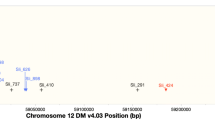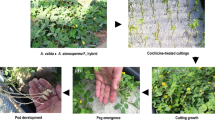Abstract
Recently proposals have been made in both Europe and North America to try to radically change potato breeding strategy from a tetraploid, heterozygous crop to a diploid inbred crop. As part of that effort, clones from the long-day adapted, late blight resistant diploid hybrid Solanum phureja – S. stenotomum population were selfed to begin the process of developing inbred lines. In March of 2016 and 2017, 42 diploid clones from the above-mentioned population were selfed in the greenhouse in Beltsville, MD. In 2016 and 2017, 10 and 13 clones failed to flower, respectively. Among the remaining clones, 716 pollinations were made in 2016, resulting in 57 fruit from 17 clones, and 3742 seeds; 801 pollinations were made in 2017, resulting in 34 fruit from 12 clones, and 1903 seeds. Nine clones were successfully selfed both years. Percent successful selfs was significantly higher in 2016 (7.96%) than in 2017 (4.24%). The most prolific clones in 2016 were BD1241–1 (34% successful selfs, 1090 seed), BD1218–3 (25% successful selfs, 638 seed), BD1215–1 (5% successful selfs, 411 seed), BD1243–1 (23% successful selfs, 232 seed). In contrast, the most prolific clones in 2017 were BD1230–2 (25% successful selfs, 537 seed), BD1203–3 (23% successful selfs, 391 seed), and BD1229–1 (11% successful selfs, 388 seed). These results indicate that there is sufficient self-compatibililty in this population to generate large numbers of inbred individuals, but that genotype x environment interactions are large. Attempts to generate selfed seed should be made over several years to maximize the genetic base of the selfed population.
Resumen
Recientemente se han hecho propuestas tanto en Europa como en Norteamérica para tratar de cambiar radicalmente la estrategia de mejoramiento de la papa de un cultivo tetraploide, heterozigotico a uno diploide, endogámico. Como parte de este esfuerzo, clones adaptados a días largos, híbrido diploide resistente al tizón tardío de una población de Solanum phureja-S. stenotomum, se autofecundaron para empezar el proceso de desarrollo de líneas autogámicas. En marzo de 2016 y 2017, se autofecundaron 42 clones diploides de la población mencionada en invernadero en Beltsville, MD. En 2016 y 2017, 10 y 13 clones fallaron en florecer, respectivamente. Entre los clones restantes, se hicieron 716 polinizaciones en 2016, que resultaron en 57 frutos de 17 clones, y 3742 semillas; en el 2017 se hicieron 801 polinizaciones, que produjeron 34 frutos de 12 clones, y 1903 semillas. Nueve clones fueron autofecundados con éxito en ambos años. El porcentaje de autofecundaciones exitosas fue significativamente mayor en 2016 (7.96%) que en el 2017 (4.24%). Los clones más prolíficos en el 2016 fueron BD1241–1 (34% de éxito en la endogamia, 1090 semillas), BD1218–3 (25% de éxito, 638 semillas), BD1215–1 (5% de éxito, 411 semillas), BD1243–1 (23% de éxito, 232 semillas). En contraste, los clones más prolíficos en el 2017 fueron BD1230–2 (25% de éxito, 537 semillas), BD1203–3 (23% de éxito, 391 semillas), y BD1229–1 (11% de éxito, 388 semillas). Estos resultados indican que hay suficiente auto-compatibilidad en esta población para generar grandes números de individuos endogámicos, pero que las interacciones genotipo x medio ambiente son grandes. Los intentos para generar semilla autofecundada deberían de hacerse a lo largo de varios años para maximizar la base genética de poblaciones endogámicas.
Similar content being viewed by others
References
Birhman, R.K., and K. Hosaka. 2000. Production of inbred progenies of diploid potatoes using an S-locus inhibitor (Sli) gene, and their characterization. Genome 43: 495–502.
Choudhuri, H.C. 1944. Cytological and genetical studies in the genus Solanum. II. Wild and cultivated diploid potatoes. Transactions of the Royal Society of Edinburgh 61: 199–219.
Cipar, M.S., S.J. Peloquin, and R.W. Hougas. 1964. Variability in the expression of self-incompatibility in tuber-bearing diploid Solanum species. American Potato Journal 41: 155–162.
de Nettancourt, D. 2001. Incompatibility and incongruity in wild and cultivated plants. 2nd ed. Berlin: Springer-Verlag.
Deward, T. 1963a. The function of incompatibility alleles in red clover (Trifolium pretense L.). II. Results of crosses with inbred families. Hereditas 49: 203–236.
Deward, T. 1963b. The function of incompatibility alleles in red clover (Trifolium pretense L.). III. Changes in the S-specificity. Hereditas 49: 285–329.
Dodds, K.S. 1956. Sporadic self-fertility in S. phureja. John Innes Institute, Annual Report: 19‑20.
Dodds, K.S. 1958. Cultivated diploid potatoes. John Innes Institute, Annual Report: 19–20.
Douches, D.S., D. Maas, K. Jastrzebski, and R.W. Chase. 1996. Assessment of potato breeding progress in the USA over the last century. Crop Science 36: 1544–1552.
Grun, P., and A. Radlow. 1961. Evolution of barriers to crossing of self-incompatible with self-compatible species of Solanum. Heredity 16: 137–143.
Haynes, F.L. 1972. The use of cultivated diploid Solanum species in potato breeding. p. 100–110. In: Prospects for the Potato in the Developing World, International Potato Center Symposium, 1972.
Haynes, K.G. 2008. Heritability of chip color and specific gravity in a long-day adapted Solanum phureja x S. stenotomum population. American Journal of Potato Research 85: 361–366.
Haynes, K.G., and B.J. Christ. 1999. Heritability of resistance to foliar late blight in a diploid Solanum phureja x S. stenotomum hybrid potato population. Plant Breeding 118: 431–434.
Haynes, K.G., and B.J. Christ. 2006. Recurrent maternal half-sib selection improves resistance to foliar late blight in a diploid hybrid Solanum phureja-S, stenotomum population. American Journal of Potato Research 83: 181–188.
Haynes, K.G., D.M. Gergela, C.M. Hutchinson, G.C. Yencho, M.E. Clough, M.R. Henninger, D.E. Halseth, E. Sandsted, G.A. Porter, and P.C. Ocaya. 2012. Early generation selection at multiple locations may identify potato parents that produce more widely adapted progeny. Euphytica 186: 573–583.
Haynes, K.G., X. Qu, and B.J. Christ. 2014. Two cycles of recurrent maternal half-sib selection reduce foliar late blight in a diploid hybrid Solanum phureja – S. stenotomum population by two-thirds. American Journal of Potato Research 91: 254–259.
Henny, R.J., and P.D. Ascher. 1976. The inheritance of pseudo-self-compatibility (PSC) in Nemesia strumosa Benth. Theoretical and Applied Genetics 48: 185–195.
Hosaka, K., and R.E. Hanneman. 1998. Genetics of self-compatible wild diploid potato species Solanum chacoense. 1. Detection of an S locus inhibitor (Sli) gene. Euphytica 99: 191–197.
Jansky, S.H., A.O. Charkowski, D.S. Douches, G. Gusmini, C. Richael, P.C. Bethke, D.M. Spooner, R.G. Novy, H. De Jong, W.S. De Jong, J.B. Bamberg, A.L. Thompson, B. Bizimungu, D.G. Holm, C.R. Brown, K.G. Haynes, V.R. Sathuvalli, R.E. Veilleux, J.C. Miller Jr., J.M. Bradeen, and J. Jiang. 2016. Reinventing potato as a diploid inbred line-based crop. Crop Science 56: 1412–1422.
Lamm, R. 1945. Cytogenetic studies in Solanum, Sect. Tuberarium. Hereditas 31: 1–128.
Lindhout, P., D. Meijer, T. Schotte, R.C.B. Hutten, R.G.F. Visser, and H.J. Eck. 2011. Towards F1 hybrid seed potato breeding. Potato Research 54: 301–312.
Malheiros-Garde, N. 1959. Mechanisms of species isolation in tuberous Solanum. Agronomia Lusitana 21: 19–42.
Nasrallah, M.E., and D.H. Wallace. 1967. Immunogenetics of self-incompatibility in Brassica oleracea L. Heredity 22: 519–527.
Pal, B.P., and Pushkarnath. 1942. Genetic nature of self- and cross-incompatibility in potatoes. Nature 149: 246–247.
Phumichai, C., M. Mori, A. Kobayashi, O. Kamijima, and K. Hosaka. 2005. Toward the development of highly homozygous diploid potato lines using the self-compatibility controlling Sli gene. Genome 48: 977–984.
Phumichai, C., Y. Ikeguchi-Samitsu, M. Fujimatsu, S. Kitanishi, A. Kobayashi, M. Mori, and K. Hosaka. 2006. Expression of the S-locus inhibitor gene (Sli) in various diploid potatoes. Euphytica 148: 227–234.
Pushkarnath. 1942. Studies on sterility in potatoes. I. The genetics of self- and cross-incompatibilities. Indian Journal of Genetics and Plant Breeding 2: 11–36.
Sawicka, E. 1971. Self compatibility in exotic potato species in the series Commersoniana Buk. Biuletyn instytutu ziemniaka 8: 5–12.
Simmonds, N.W. 1960. The breeding system of the cultivated diploids. John Innes Institite, Annual Report: 28–29.
Stout, A.B. and C.F. Clark. 1924. Sterilities of wild and cultivated potatoes with reference to breeding from seed. USDA Bull. No. 1195, 32 p.
Takahashi, H. 1973. Genetical and physiological analysis of pseudo-self-compatibility in Petunia hybrid. Japanese Journal of Genetics 48: 27–33.
Author information
Authors and Affiliations
Corresponding author
Rights and permissions
About this article
Cite this article
Haynes, K.G., Guedes, M.L. Self -Compatibility in a Diploid Hybrid Population of Solanum phureja – S. stenotomum. Am. J. Potato Res. 95, 729–734 (2018). https://doi.org/10.1007/s12230-018-9680-y
Published:
Issue Date:
DOI: https://doi.org/10.1007/s12230-018-9680-y




